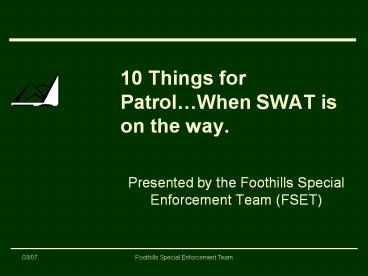10 Things for Patrol - PowerPoint PPT Presentation
Title:
10 Things for Patrol
Description:
10 Things for Patrol When SWAT is on the way. Presented by the Foothills Special Enforcement Team (FSET) First Responder Obligations It s easy to become ... – PowerPoint PPT presentation
Number of Views:398
Avg rating:3.0/5.0
Title: 10 Things for Patrol
1
10 Things for PatrolWhen SWAT is on the way.
- Presented by the Foothills Special Enforcement
Team (FSET)
2
First Responder Obligations
- Its easy to become overwhelmed by events (EOB),
prioritize what needs to be accomplished first
based on the circumstances. - Active shooter-immediate response
- Officer/citizen down-requires a rescue plan
- Hostage Situation-Immediate containment to
control suspects movement. Formulate a hasty
rescue plan in case suspect initiates a deadly
assault on victims.
3
First Responder Obligations
- As additional resources arrive, set larger
perimeter. - Assign a supervisor to oversee the overall
effort, who will become Swat's point of contact.
Ensure they have a solid understanding of what
the situation is and what goals you are trying to
achieve. - Be mindful that these situations can last many
hours. Remember to care for the needs of the
personnel involved.
4
Types of SWAT Responses
- Barricaded Suspects
- Hostage Situations
- High Risk Search Warrants
- Executive/Witness Protection
- Events that require an immediate resource of
tactical personnel.
5
Lesson 1Cover and Concealment
- Vehicle Positioning- Dont park too close or
directly in front of the location. Be conscious
of ingress and egress for quick escape. - Cover- Start looking for cover from potential
rifle/handgun fire. Cover is any object that
will stop a bullet or at least slow it down,
protecting your vital areas, and not limiting
your chance to observe the situation and return
fire if needed.
6
Lesson 1 (Continued)
- Example of Cover Brick/stone wall, large tree
trunks, Engine - Example of Concealment Thick hedges, bushes,
wood, fences, nighttime.
7
Lesson 2Evacuate Potential Hostages/Neighbors
- Any person that you can safely get out of area,
do so immediately. - The ultimate goal is to isolate the armed
subject. - Create a safety zone for SWAT.
- If situation is too dangerous, advise citizens to
stay in their homes until the incident is
resolved or the police can safely remove.
8
Lesson 3Cover Areas of Escape
- Good chance the suspects may know SWAT is
responding. - Tactically cover areas of possible escape.
- Avoid allowing gunman on the move, setting up an
ambush from a new position. - The goal is to contain/isolate the threat.
9
Lesson 4Set up a Perimeter
- Block off areas with crime scene tape.
- Stop all pedestrian and traffic flow into the
area. - Perimeter determined by type of incident and
weapons involved (handgun, long rifle, etc). - Outside of perimeter is for CP and for
neighbors/pedestrians. - Inside of tape for SWAT, CNT, and first
responders until relieved by SWAT.
10
Lesson 5Pick a suitable staging area
- The staging area is a safe place where SWAT can
suit up, get together and prepare strategy. - Usually place where CP is located.
- Area should not be too far from the incident, but
definitely out of the line of sight of the
incident. - If the crook can see you, they can shoot at you.
- The area should be a place to freely go over
options and plan tactics in a secure environment
that is large enough to accommodate personnel,
vehicles, and resources.
11
Lesson 6Gather Intelligence
- Talk to friends, family, and neighbors.
- Try to ascertain if the subject is really armed
and what type of weapon(s) they have. - Gather intelligence (Age, race, clothing,
home/cellular phone, statements, etc.) - Be ready to pass info along to SWAT
12
Lesson 6Gather Intelligence (Continued)
- Alcohol/Drugs
- Suicidal
- Medication/Mental
- Talk to Family/Friends
- Layout of Property
- Floor Plan
- Dogs
13
Lesson 7Keep Lanes of Traffic Open
- The first officers on scene should transmit over
the radio to other responding officers safe areas
to park. - Keep a clear path from the staging area to target
property. - Numerous types of vehicle may be moving into the
area (Fire Trucks, ARVs, Ambulances) - It may be necessary to remove and transport
injured officers, hostages, or even the suspect.
14
Lesson 8Bring order to Chaos
- Patrol officers are the ones that must deal with
all the confusion and chaos at a scene. - Keep crowd back and out of the way.
- SWAT has main task of dealing with the
barricade/hostage/etc, while attention to any
distractions is patrols responsibility. - Patrols coordination is in dire need to deal
with various new supervisors, new media, fire
department/paramedics, and the growing audience
of bystanders.
15
Lesson 9Know your role
- When SWAT arrives, brief them as clearly as
possible. - Use radio and let other patrol officers SWAT is
arriving and what role they are playing. - Let SWAT officers where patrol officers are
positioned. - SWAT may call on you to move people back inside
their homes, out of the line of sight, or to get
away from their windows.
16
Lesson 9Know your role (Continued)
- Know your limitations.
- SWAT has heavy ballistic protection, weaponry,
chemical agents, breaching equipment, and tactics
to deal with the situation. - This is what SWAT trains for!
- Once the weapons team arrives, your role changes.
Your new position will most likely be at the
perimeter.
17
Lesson 10Use your common sense
- As the crisis unfolds, usually at breakneck
speed, take a deep breath and plan your actions
accordingly. - As the situation develops, you are the first one
to deal with the danger and make the initial
decisions. - To quote General Patton, A good solution applied
with vigor now is better than a perfect solution
applied ten minutes later.

